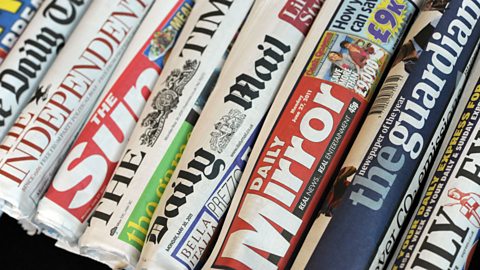Newspaper article

There are several different types of newspaper articles:
- News articles - these are found at the front of a newspaper. They inform readers about things that are happening in the world or in the local area. They will be full of facts, like names, dates and places.
- Feature articles - these explore news stories in more depth. The purpose of a feature is not just to tell you what has happened, but to explore or analyse the reasons why. These kind of pieces normally name the writer who wrote them - a byline.
- Editorials, columns and opinion pieces - these are pieces by 'personality' writers. They might be there to inform (because the writer's expert opinion is valued), or they might be there to entertain (because the writer has a comic or interesting way of describing everyday life). They are likely to have a more personal style that the writer regularly uses when writing - this could be shown through particular vocabulary or the opinion of the writer.
The type of newspaper that the article is published in makes a difference to the way it is written:
- if it is in a tabloidA newspaper with small pages, usually with simpler writing. it will have shorter sentences and paragraphs and use more basic vocabulary
- if it is in a broadsheet A newspaper that uses formal language and tends to be regarded as more serious and business oriented than a tabloid. the sentences will be longer and more complicated, and the vocabulary will be more advanced
Some newspapers also have particular political points of view, which might affect how they report events in the news.
Example
This feature article is from The Daily Telegraph which is a broadsheet paper. Only the first part of the article is given here. It is from the morning of the semi-final of Wimbledon, in the year that Andy Murray won.
Andy Murray's appliance of science
If the Caledonian superman wins Wimbledon this year, it will be thanks to 50 pieces of sushi a day, a magic potion and a battalion of experts.
If you want to know what it is about Andy Murray that makes him stand out from the rest of us â apart from that fizzing backhand return and the huge-mouthed celebratory yodel â it is summed up in two words: osmolarity check.
Today, before he even steps out on to the Centre Court for his Wimbledon semi-final against the huge-hitting Pole Jerzy Janowicz, Murray will have been subject to several of these. He does one every time he pops to the lavatory. The osmolarity check is conducted by one of his staff, its purpose to gauge the percentages of water and minerals in his urine, to show whether his body is correctly hydrated. The fact is, if Murray wins today, it will partly be thanks to the bloke who inspects his wee.
There has never been a sportsman who has been as meticulously assembled as Andy Murray. Allied to his extraordinary natural skill and ferocious desire to win, what has carried him to his fifth successive Wimbledon semi-final is the relentless appliance of science. There is nothing in his life that is left to chance, nothing that is not measured, calibrated and balanced. This is a man whose route to the summit of his profession has been mapped with a meticulousness bordering on the obsessive.
Take his diet. He will have started eating at 7.30 this morning. While many of those arriving at Wimbledonâs press restaurant will have begun their day assaulting a tottering Himalaya of fried starch, Murray will have eaten yogurt, fruit and a bagel smeared in peanut butter.
By Jim White, Daily Telegraph
Analysis
This article:
- has a headline to grab attention, and a subtitle to tell the reader more about what the feature is really about â the scientific support for professional sports players
- uses literary deviceAny method an author uses to add meaning or interest to a text, such as metaphors, similes or alliteration. to entertain, like the metaphor describing the journalistsâ breakfasts as a âtottering Himalaya of fried starchâ
- uses humour to engage the audience â such as talking about his scientific support as âthe bloke who inspects his weeâ
- understands that the reader would not be an expert in this topic and explains the meaning of technical terms like âosmolarity checkâ